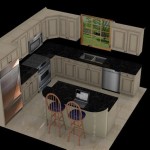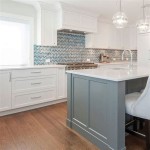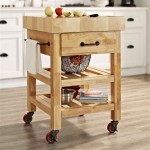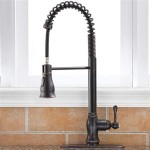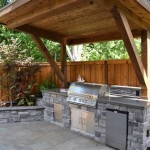Kitchen Cabinets With Appliance Garage: Maximizing Space and Functionality
The modern kitchen is increasingly recognized as the heart of the home. It's a space where meals are prepared, families gather, and memories are made. With the rising cost of real estate and a desire for efficient living, optimizing kitchen space has become a paramount concern for homeowners and designers alike. One innovative solution for achieving this optimization is the incorporation of kitchen cabinets with appliance garages.
An appliance garage, also sometimes referred to as an appliance hideaway or a roll-up garage, is essentially a cabinet designed to conceal small appliances, such as toasters, blenders, coffee makers, and food processors, when they are not in use. These garages are integrated into the overall kitchen cabinet design, providing a seamless and uncluttered aesthetic. They contribute significantly to a more organized and visually appealing kitchen environment.
The functionality of kitchen cabinets with appliance garages extends beyond mere aesthetics. They facilitate easier countertop maintenance, protect appliances from dust and grease, and ultimately enhance the overall efficiency of the kitchen workflow. This article will delve into the various aspects of kitchen cabinets with appliance garages, highlighting their benefits, design considerations, installation aspects, and maintenance requirements.
Key Benefits of Appliance Garages in Kitchen Design
Appliance garages provide a multitude of advantages for kitchen design and functionality. Their core benefit lies in the ability to declutter countertops and present a clean, organized workspace.
Firstly, appliance garages contribute significantly to
countertop decluttering
. Countertops are valuable real estate in any kitchen. Small appliances, if left out permanently, can quickly consume this space, leaving limited room for food preparation and other kitchen tasks. By housing these appliances within a dedicated garage, countertops become freed from clutter, providing a more spacious and functional work area. This is particularly beneficial in smaller kitchens where every inch of countertop space is crucial.Secondly, appliance garages offer
protection for appliances
. When appliances are stored inside a cabinet, they are shielded from dust, grease splatters, and other potential contaminants that are common in a kitchen environment. This protection can extend the lifespan of the appliances and reduce the frequency of cleaning required. Furthermore, the enclosed space prevents accidental bumps or knocks, minimizing the risk of damage to the appliances.Thirdly, appliance garages promote a
streamlined kitchen aesthetic
. A kitchen with clear countertops appears more modern, organized, and visually appealing. By concealing appliances when they are not in use, the appliance garage contributes to a clean and minimalist design aesthetic. This can be particularly advantageous for homeowners who value a sleek and uncluttered living space.Finally, appliance garages can improve
kitchen workflow
. When appliances are readily accessible but out of sight, they are easy to retrieve and use when needed. This eliminates the need to rummage through cabinets or drawers to find the required appliance, saving time and effort in the kitchen. The dedicated space for appliances also helps to maintain a more organized and efficient cooking routine.Design Considerations for Kitchen Cabinets with Appliance Garages
The design of a kitchen cabinet with an appliance garage requires careful consideration of several factors to ensure optimal functionality and aesthetics. These considerations range from size and placement to door styles and internal features.
The
size of the appliance garage
must be carefully determined based on the dimensions of the appliances it is intended to house. It is crucial to measure the height, width, and depth of the largest appliance that will be stored in the garage, adding extra clearance for easy access and ventilation. Inadequate space can render the garage unusable, while excessive space can be wasteful. The depth of the appliance garage should also align with the standard depth of base or wall cabinets, to maintain a cohesive kitchen design.The
placement of the appliance garage
within the kitchen layout is another critical factor. Ideally, it should be located near a power outlet to facilitate easy operation of the appliances. The placement should also consider the frequency of use of the appliances. Appliances that are used frequently should be placed in an easily accessible location, while those used less often can be positioned in a less convenient area. Consider the overall workflow of the kitchen when determining the optimal placement of the appliance garage.The
door style of the appliance garage
should complement the overall design of the kitchen cabinets. Common door styles include roll-up doors, hinged doors, and flip-up doors. Roll-up doors are a popular choice for their space-saving design and ease of use. Hinged doors provide a more traditional look and feel, while flip-up doors offer a modern and sleek aesthetic. The choice of door style should be based on personal preference and the overall design of the kitchen. It's important to ensure that the door mechanism operates smoothly and reliably.The
internal features of the appliance garage
can be customized to suit specific needs. Options include adjustable shelves, pull-out trays, and built-in power outlets. Adjustable shelves allow for flexible storage of appliances of different sizes, while pull-out trays provide easier access to appliances stored at the back of the garage. Built-in power outlets eliminate the need for unsightly extension cords and provide a dedicated power source for the appliances within the garage. Internal lighting can also be added to enhance visibility and make it easier to locate appliances.Finally, consider the
ventilation
within the appliance garage. Some appliances, such as toasters and coffee makers, generate heat during operation. Adequate ventilation is essential to prevent overheating and potential damage to the appliances or the cabinet. Ventilation can be achieved through strategically placed vents or by leaving a small gap at the back of the garage.Installation and Maintenance of Appliance Garages
Proper installation is crucial for the long-term functionality and durability of kitchen cabinets with appliance garages. While some homeowners may attempt DIY installation, professional installation is generally recommended to ensure accuracy and prevent potential problems.
The
installation process
typically involves integrating the appliance garage cabinet into the overall kitchen cabinet layout. This requires precise measurements and careful alignment to ensure a seamless fit. The cabinet must be securely attached to the wall or base cabinets to prevent movement or instability. The door mechanism must be properly installed and adjusted to ensure smooth and reliable operation. If built-in power outlets are included, they must be installed by a qualified electrician to ensure safety and compliance with electrical codes. Proper sealing around the edges of the cabinet can help to prevent moisture damage and maintain a clean and hygienic environment.Maintenance of appliance garages
is relatively simple, but regular cleaning is essential to prevent the buildup of dust, grease, and food particles. The interior of the garage should be wiped down regularly with a damp cloth and mild detergent. The door mechanism should be lubricated periodically to ensure smooth operation. Any spills or stains should be cleaned up immediately to prevent permanent damage. If the appliance garage is equipped with ventilation, the vents should be cleaned regularly to prevent blockage.Choosing the right
materials
for kitchen cabinets with appliance garages is essential for longevity and durability. Solid wood, plywood, and MDF (Medium-Density Fiberboard) are common materials used in cabinet construction. Solid wood offers the best durability and aesthetic appeal, but it is also the most expensive option. Plywood is a good compromise between durability and cost. MDF is a less expensive option, but it is not as durable as solid wood or plywood. The hardware, such as hinges and door pulls, should be made of high-quality materials to ensure smooth operation and prevent premature wear and tear.Finally, consider the
overall kitchen design
when planning for an appliance garage. The style, color, and finish of the cabinet should complement the rest of the kitchen cabinets and décor. A well-designed appliance garage can seamlessly blend into the kitchen and enhance its overall aesthetic appeal. It's important to work with a kitchen designer or cabinet maker to ensure that the appliance garage is properly integrated into the kitchen layout and design.
The Modern Day Appliance Garage A Moveable Backsplash To Hide Our Small Appliances Chris Loves Julia

How To Diy A Kitchen Appliance Garage Semistories

Wall Appliance Garage With Doors Homecrest

Kitchen Appliance Garage Diy Angela Marie Made

Appliance Garage Ideas Kitchen Remodeling Tricks

The Modern Day Appliance Garage A Moveable Backsplash To Hide Our Small Appliances Chris Loves Julia

Corner Appliance Garage For Clean Counters Hidden Storage

Appliance Garage Ideas Kitchen Remodeling Tricks

Omega National Products Ag 100cvr Solid Wood Face Frame Appliance Garage Kit For 24 X Inch Cross Corner Wall Cabinet Including Veneer Tambour Door Spring Tension Track System And End Panels 18 1 2

Appliance Garage Ideas Transform Your Kitchen Into A Clutter Free Haven Decorilla Online Interior Design

